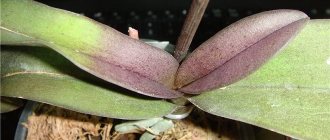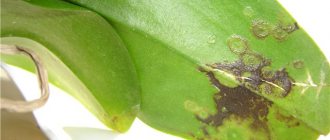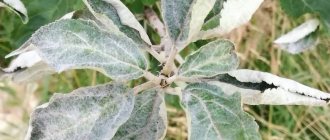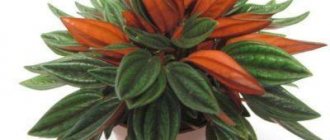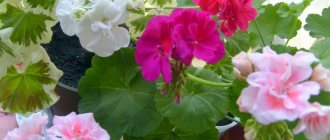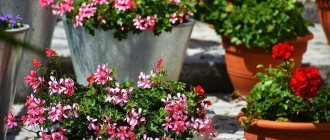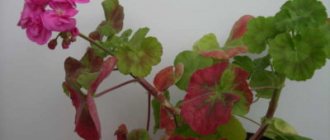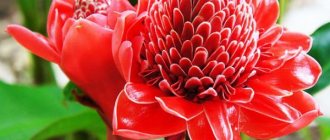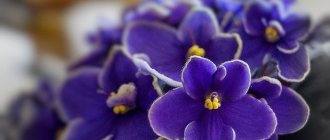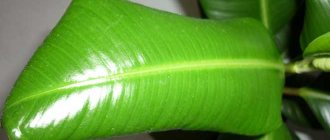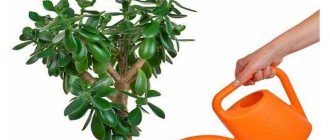Author: Elena N. https://floristics.info/ru/index.php?option=com_contact&view=contact&id=19 Category: Houseplants Published: December 09, 2013Last edits: January 11, 2021
- Velvety Peperomia / Peperomia velutina
Botanical description
Peperomia (lat. Peperomia) is a representative of plants from the Pepper family. At the moment, more than 1000 species of peperomia are already known, which grow under natural conditions in the tropical zones of America. The name of the plant consists of two words: peperi (Greek) - pepper, and homois (Greek) - similar. Representatives of peperomia are subshrubs, evergreen perennials or annual herbs. The shoots of the plants are thick, the leaves are leathery, dense, located oppositely throughout the stem. The plant is grown as an ornamental foliage plant, although peperomia blooms with small flowers. The plant is grown both indoors and in gardens (special conditions are created). Some types of peperomia are interesting not only for their leaves, but also for their flowers, but flowering can be achieved when grown under “short days”. Some species are grown as hanging plants. The plant is great for creating flower arrangements.
Benefit
The compact bush of magnolia-leaved peperomia is called “friendly family”. Having such a plant in your home is desirable for those whose character displays contradictions and rebellion. The plant is able to smooth out the intransigence of such people. Peperomia brings an atmosphere of goodwill and peace into the home.
Plants with striped color help to overcome difficult periods of life, as if bringing brighter days closer. From a physiological point of view, this plant affects the digestive system and gall bladder, normalizing their functioning.
Peperomia is especially beneficial for air purification; it can kill pathogenic microbes.
Briefly about cultivation
- Flowering: the plant is grown as an ornamental foliage plant.
- Lighting: bright diffused light. Forms of peperomia with green leaves are not as dependent on light as the variegated varieties.
- Temperature: in summer and spring – about 22 ºC, in winter – 17-18 ºC.
- Watering: during the growing season - abundantly, and in winter the substrate is moistened so that the earthen lump does not dry out.
- Air humidity: normal for residential premises, but in the summer heat it is advisable to spray the foliage early in the morning or in the evening.
- Feeding: every two weeks from spring to autumn with complex fertilizer for decorative deciduous plants.
- Rest period: not clearly expressed.
- Transplantation: up to three years of age, an annual replantation is required, and thereafter - once every two years.
- Substrate: 3 parts of leaf soil and 1 part each of humus soil, peat and sand.
- Reproduction: seeds, leaf and stem cuttings, division of rhizomes.
- Pests: spider mites, thrips, scale insects, mealybugs and nematodes.
- Diseases: stem rot, loss of decorativeness by leaves, falling leaves due to violation of maintenance conditions and improper care.
Read more about growing peperomia below.
Etiology
Violation of the chemical composition of the enzymes involved in the production of heme leads to the formation of metabolites that are toxic to humans. Chronic forms of porphyria are characterized by the accumulation of protoporphyrin, coproporphyrin and uroporphyrin in tissues. Acute types of the disease develop against the background of increased concentrations of porphobilinogen and delta-aminolevulinic acid (DALA) in the blood.
The accumulation of porphyrins in the skin of children and adults occurs under the influence of ultraviolet radiation. A side effect of this process is lipid oxidation. Skin cells die when exposed to sunlight. Coproporphyrin provokes increased pigmentation of the dermis and increased hair growth. Deposition of protoporphyrin in the liver causes blockage of the bile ducts. Uroporphyrins lead to accelerated destruction of red blood cells in the spleen. DALK and porphobilinogen accumulate in nerve tissues and trigger the process of axonal degeneration.
Peperomia care at home
Lighting
Indoor peperomia needs bright lighting, but direct sunlight should not be allowed to hit the leaves. When grown on the south side, the plant is placed either in the back of the room, or the light is diffused using paper. When grown on the western or eastern side, shading is not required. On a northern windowsill there may be little light and you will have to resort to artificial lighting. Forms of peperomia with green leaves are shade-tolerant, while those with variegated leaves need more bright light. In winter, the lighting should also be bright.
Temperature
Temperatures should be average throughout the year. In summer and spring, peperomia feels best at home at a temperature of about 22 °C. In winter, the temperature is reduced by literally a couple of degrees, but a drop below 16 °C can lead to illness. Only some types of domestic peperomia can be taken outside, so it is better not to take risks, since drafts are detrimental to the plant.
Watering peperomia
During the growing season, water the homemade peperomia plant abundantly; use soft water, a couple of degrees warmer than room temperature, and settled water. In autumn and winter, watering is reduced, using the rule “it is better to under-water than to over-water,” since excess moisture in the soil leads to rotting of the roots, which is always difficult to combat. If the leaves of the peperomia wither and fall off, this indicates insufficient watering.
- Laurel (Laurus) – care, photos, types
Spraying
For the peperomia plant, air humidity is not an important point in care. Spraying can have a positive effect on the development of the plant, and its absence will at least not cause harm. Spraying from June to August will be beneficial.
Top dressing
Fertilizers use complex mineral fertilizers for indoor plants. Peperomia is fed every two weeks during the spring-autumn period, and once every winter month.
Trimming
The tips of the shoots can be pinched, which promotes better branching of peperomia.
Peperomia transplant
The pot for transplanting peperomia indoors should be shallow, and with each transplant, the next pot should be taken 2-3 cm wider in diameter. Expanded clay or broken bricks are poured onto the bottom of the pot, and an earthen mixture on top, consisting of two parts of leaf soil, and one part each of humus, sand and peat. Until the age of three, peperomia are transplanted annually, and after that - every two years.
Growing from seeds
Sow seeds in March-April. First you need to prepare a mixture of equal parts of sand and leaf soil; this substrate is poured into bowls, into which peperomia seeds are then sown. The container with the crops is moistened (you can spray the soil or pour water through a fine sieve), covered with glass or cellophane, and the temperature is kept at 25 °C. The glass or film is removed from time to time, the container is ventilated and the soil is moistened. When the second developed leaf appears on the peperomia flower seedlings, the seedlings dive into a box with the same substrate at a distance of 2 cm from each other. Lighting should be bright and long, but without direct sunlight. When the plants become stronger, they are planted in individual pots 7 cm in diameter. A drainage layer is poured onto the bottom of the pot, and a substrate of sand, turf soil, leaf and peat (1: 1: 2: 2) is placed on top. Next, they are cared for as for an adult peperomia.
Propagation by stem cuttings
For cuttings of indoor peperomia flowers, make a mixture of equal parts of sand, peat and humus. Both apical and stem cuttings are suitable. Depending on the length of the internodes, it is necessary that there are from one to three nodes on the cutting. Cuttings take root both in water and in the substrate (see above). The cuttings are planted in soil and covered with glass, the temperature is maintained at 25 °C, and in less than a month the cuttings should take root. Peperomia cuttings are planted in individual pots and cared for as for adult specimens.
- Photo of hibiscus with species names
Leaf propagation
To propagate homemade peperomia by leaf, you need to use a sharp knife, or better yet, a blade, to cut off a healthy leaf (there should be no signs of disease, no pests, no damage). The petiole of the leaf is kept short. The leaf is planted in a mixture of peat and sand, placed in water or rooted in living sphagnum moss. Rooting will be faster and more likely to be successful in a greenhouse. The water must be changed every 1-2 days. After 3-4 weeks, the peperomia leaf will take root, after which it is transplanted into a pot 7 cm in diameter. When the plant becomes stronger, it is given the usual care.
Dividing the bush
If the peperomia bush has grown greatly, it can be divided into 2-3 small ones. This is done in the spring, combining replanting with root division. Separate the plants carefully so as not to damage the root system. The soil is taken as described in paragraph Transplantation (see above). We pour drainage into the bottom of the pot; the pot itself should be taken a little smaller.
Reproduction
To keep peperomia beautiful, it is worth preparing new young cuttings every 2 years. Depending on the species, propagation can be carried out by shoot or leaf cuttings:
- Propagation by apical cuttings. Using a clean, sterile instrument, cut off the top of the shoots 5 cm long, cut off the lower leaves, dip the tip of the stem in a rooting preparation, then plant it in pots. You can root cuttings in water, preferably with the addition of activated carbon. After 3 weeks, the young plants take root.
- Leaf cuttings - place the leaf petiole in water or directly in the substrate. It is important to provide the seedlings with a bright position with high air humidity.
Diseases and pests
Peperomia leaves are falling off. The most common options: either keeping the plant at a low temperature, or insufficient watering (drying out the earthen coma).
The edges and tips of peperomia leaves turn brown. In peperomia, these are signs of sudden temperature changes (sharp drops). Another reason is that the plant is in a draft; this should not be allowed.
Peperomia leaves and stems rot. The reason for this is excessive soil moisture. Symptoms appear more quickly if waterlogging is accompanied by conditions below 16°C.
Peperomia leaves wither and wrinkle. Peperomia should not be in direct sunlight. Location on southern window sills can also lead to burns on the leaves.
Peperomia pests. If not properly cared for, peperomia is easily attacked by mites, thrips, nematodes, scale insects and mealybugs. Read how to deal with them in the pests section (see the Plants menu item at the top of the site).
- Groups of indoor plants (part 3)
general information
Porphyrin disease is diagnosed relatively rarely: Russian doctors detect no more than 12 cases per 100 thousand people. Various forms of pathology are becoming widespread in certain regions of the Earth. Thus, signs of porphyria cutanea tarda are often detected in residents of South Africa (1 case per 800 people). Acute intermittent type of disease is typical for residents of Northern Europe (1 case per 1000 people). Men and women are equally likely to suffer from various forms of heme synthesis.
Kinds
Velvety Peperomia / Peperomia velutina
Natural habitat – Ecuador. Representatives of the species are herbaceous perennials. The stem of the plant is pubescent, straight, vertical, dark red in color. Leaf petioles are short (up to 1 cm long). The leaf plate is round in shape, green in color, from the top from the base of the leaf to the top there are five to seven veins of light green color, depending on the variety, the leaves can be either bare or covered with small hairs, the leaves are arranged alternately on the shoot. The flowers are 7-centimeter spikelets appearing from the leaf axils or at the ends of the branches.
Peperomia clusiifolia
Distributed in Venezuelan tropical forests. Representatives of the species are herbaceous perennials. The leaves of the species are dense, petiolate, sessile, dark green in color with a slight shade of red, arranged alternately on the shoot, the length of the leaf blade reaches 15 cm, and a maximum width of 8 cm, the edge of the leaf is purple, the apex of the leaf is usually obtuse, the base is wedge-shaped.
variegata variety has variegated leaves and is not as dense. The edge of the leaf is reddish, closer to the center the leaf is yellow, and near the vein itself it becomes dark green. Not found in nature.
Reddish Peperomia / Peperomia rubella
This species is a herbaceous branched perennial with red thin shoots. The leaves on the shoots are arranged in 4 leaves opposite, the upper side of the leaf blade is green, and the lower side is red, small in size, and has an elongated oval shape. The plant is very decorative.
Peperomia maculosa
The homeland of this species is the tropical mountain forests of the South American continent. Representatives of the species are herbaceous perennials. The shoots are green, covered with brown spots. The leaves are dark green with white veins, grow from the root, grow up to 20 cm in length, ovoid, shiny, rather dense. The inflorescences are brown in color and quite long.
Peperomia marmorata
Grows in Brazil. A representative of the genus is a low-growing herbaceous perennial that grows densely. The leaves are heart-shaped, rounded, green in color with brownish veins extending from the base of the leaf towards the apex.
Creeping Peperomia / Peperomia serpens
This epiphytic perennial grows naturally in swampy forests in the tropical zones of the American continent. Shoots can be hanging, vertical, or recumbent. The leaves are petiolate, the base of the leaf blade has a heart-shaped notch, and the leaf itself is flattened-ovate in shape, can be pure green or have a variegated color. The leaves on the shoots are arranged alternately. Grown as an ampelous plant.
Peperomia blanda
Grows in tropical forests of South America. The plant is epiphytic, perennial. The shoots are densely covered with hairs. The leaves are arranged oppositely on the shoots, three or four at a time, small (up to 4 cm long and up to 1.5 cm wide), oval in shape. The leaf blade is red underneath and green on top.
Gray Peperomia / Peperomia incana
Grows in Brazil. Herbaceous perennials or subshrubs, grow up to 0.5 m in height. The shoots are densely covered with hairs. The rounded leaves grow up to 50 mm in diameter, are dense, covered with white hairs, the leaf blade itself is green, slightly tapering towards the apex.
Silver Peperomia / Peperomia argyreia
Habitat: Brazil and Venezuela. Stemless epiphytic or terrestrial perennials. The leaves are petiolate, petioles up to 10 cm long, with a red tint, growing from the root. The leaves are not pubescent, dense, fleshy, shiny, with 7-9 green veins, between which there are whitish stripes.
Peperomia caperata
This species is native to Brazil. The plant is not tall, only up to 10 cm. The leaves are petiolate, growing from the root, as if rosette. The petioles are ribbed, pale pink. The leaves are covered with veins that are concave on the upper side of the leaf and strongly convex on the lower side. The leaves are green, the veins are brown. The flowers are white spikelets and appear in the summer months. The plant is grown not only as an ornamental foliage plant, but also for its flowers.
Peperomia obtusifolia
Natural habitat - tropical zones of the South American continent, grow both on the ground and on trees. Representatives of the species are herbaceous perennials. The shoots are not pubescent. The leaves are petiolate, arranged alternately on the shoots, dark green in color, ovoid in shape (tapering towards the base and widening towards the apex), up to 8-12 cm long and up to 4-5 cm wide, fleshy and dense. A large number of forms and varieties are grown in culture.
Diagnostic measures
Diagnosis of porphyria is performed by a hematologist. The doctor examines the child or adult and includes in the history all the symptoms that may indicate disturbances in the process of heme synthesis. The patient will have to answer questions about medications taken, diet, and previous infectious diseases. The doctor asks the girls about the stability of the menstrual cycle, pregnancies and abortions.
The next stage of diagnosis is laboratory tests. Patients are prescribed:
- general clinical and biochemical blood tests;
- Ehrlich test;
- study of enzyme concentrations in the blood;
- PCR tests for hepatitis;
- molecular genetic research.
If there are appropriate indications, the child or adult attends a consultation with a dermatologist, nephrologist and gastroenterologist. Differential diagnosis allows doctors to exclude neurological and psychiatric pathologies from the patient’s medical history.
Forecast
Porphyrin disease is a pathology with a poor prognosis. Patients with the erythropoietic type of disorder live 25–30 years after diagnosis and initiation of treatment. The cause of death in 85% of cases is secondary infections that develop against the background of weakened human immunity. Acute porphyrias are fatal in 15–20% of clinically recorded cases. The patient's death occurs as a result of paralysis of the respiratory muscles.
PKP remains a relatively benign form of porphyrin disease. Men and women are advised to avoid factors that provoke complications: poor diet, stress, excessive insolation.
